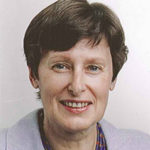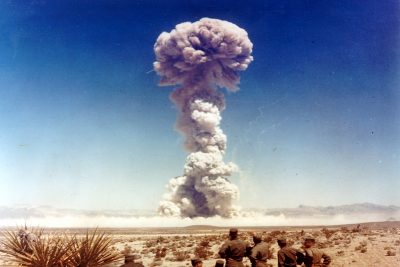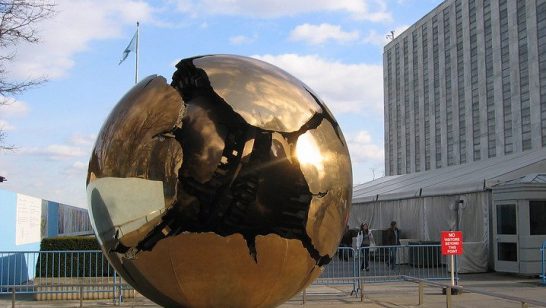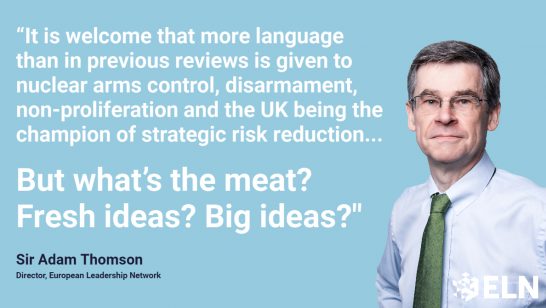
The arms control architecture which constituted a strong pillar of strategic stability even in the highly rivalrous Cold War environment has crumbled. Strategic inattention and lack of political prudence have taken the Doomsday Clock to only 100 seconds to midnight, the closest it has ever been to civilization-ending apocalypse.
To be sure, the Biden’s administration’s decision in early 2021 to extend the New START has won a reprieve of five years to a dangerous nuclear arms race between Moscow and Washington. Yet, as great powers continue to upgrade their inordinately lethal nuclear arsenals with new delivery systems and technological capabilities, decisive steps to promote strategic stability in a world of great power competition must be taken now.
After much hope, lack of political will has made the Non-Proliferation Treaty Review Conference (RevCon) – to take place in January 2022 – look likely to be rather anticlimactic. As everyone has focused on the timing of the twice-postponed conference, the substance of the discussions has regrettably receded into the background. Moreover, after much deliberation, civil society will be allowed to attend but only in small numbers. The conference will thus lack the energy of side events, of advocacy and tenacity that are the hallmarks of societal actors clamoring for nuclear disarmament. Who could ever forget the one million people demonstrating in Central Park in New York forty years ago to demand an end to nuclear weapons?
Consultations on the outcome document of the RevCon are already underway. Hopes are expressed that it will be adopted by consensus unlike in 2015 – but will that be a positive outcome? Will consensus language not paper over the deep divisions that exist between the five nuclear-weapon States (P5) and the majority of non-nuclear weapons possessors who are struggling for meaningful disarmament measures?
Meanwhile other Non-Proliferation Treaty (NPT) member states are accelerating their nuclear programmes. The UK, for instance, has increased the cap on its nuclear arsenal (from 225 to 269 warheads) rather than lowering the number (to 180) as it had previously declared.
The oft-repeated mantra that “the NPT is the cornerstone of non-proliferation” has sadly become anachronistic. The NPT was crucially important in its time, but 51 years later, it cannot continue on autopilot. Political leaders of the P5 states in particular must take into account that the world has changed and is shaped by growing multipolarity and increasing systemic competition between great powers. This constitutes a much more complex strategic environment than the one of Cold War bipolarity.
The P5 statement that was issued in Paris on 3 December disappoints. It reiterates previous bland language on non-proliferation, cites Article VI of the NPT verbatim, and has much aspirational language without announcing practical irreversible steps. The P5 “exchanged updates”, “reiterated their commitment to ongoing discussions”, “recognized their responsibility to work collaboratively” and similar formulations.
While it is welcome that the P5 “reiterated their commitment” to continue discussions on their respective nuclear doctrines and policies, their intention to “build on their fruitful work” is projected into the next NPT review cycle, without a commitment to tangible action to reduce nuclear weapons or to disarm.
In terms of concrete undertakings, therefore, the statement is meagre: they decided to launch a pilot project to develop a Young Professionals Network of P5 academics. In the tense geopolitical environment among the P5, I am mindful that common language is hard to agree on, but I am concerned that this P5 statement will not be sufficient to restore the credibility of Article VI.
Given our doomsday predicament, what should be done in advance to unlock the potential of the 2022 NPT RevCon and nurture creative strategic action?
Fundamentally, a discussion for a straightforward reduction in the numbers of nuclear weapons that are matched one-to-one would be highly welcomed. This would give a strong signal to the non-nuclear weapons States that actual disarmament would indeed take place, rather than an open-ended dialogue which could drag on for years. Angela Kane
Meanwhile, it remains important to discuss issues of nuclear doctrine and the impact of non-strategic nuclear weapons, missile defenses and long-range conventional strike systems on strategic stability. Developments in space and cyber domains are also crucial in this dimension.
For such a discussion, to be productive, however, engagement between the US and Russia alone does not suffice. China, while possessing a much smaller nuclear arsenal, is a formidable power expanding its technological capabilities across the strategic board. The recent virtual meeting between President Biden and Chairman Xi resulted in the agreement to engage in strategic stability talks, a decision that was widely welcomed. Yet the language is carefully worded: “we would look to begin to carry forward discussion”, US national security adviser Jake Sullivan said in a reference to US concerns about China’s nuclear and missile buildup.
It is clear that we need a new overarching vision for nuclear arms control, one that goes beyond the consideration of “missile gaps.” A more holistic approach is urgent, one which takes into account the geopolitical changes, the technological breakthroughs and the way that war fighting is changing. Angela Kane
And that brings us to the guardians of the NPT. The three depositary States (Russia, the UK and the US) in particular hold a special responsibility for the NPT, and they need to facilitate a constructive P5 (including China and France) relationship with the rest of the NPT membership. Views among the P5, however, have been static for a long time. It is no longer enough to repeat the mantra that the NPT is the cornerstone of non-proliferation. The disarmament part must be brought into the discussion to signal commitment to non-nuclear member states.
A strong positive signal would be solidified if the P5 and those under their nuclear umbrella would attend the first Conference of States Parties of the Treaty for the Prohibition of Nuclear Weapons as observers. This meeting will now take place in March 2022, and attendance would at a minimum indicate respect for differing positions on nuclear weapons possession.
The time to the RevCon should also be spent on thinking about the work and aims of the NPT review process. Despite commitments made by consensus during previous conferences, their implementation has stalled. It is not enough to dismiss previous agreements as “outdated” – a view that only few states hold – a serious effort is needed to build common ground and find a way forward given previous commitments. In that sense, the Foreign Affairs Council of the European Union’s November 15th conclusions which supported all three pillars of the NPT and stated the EU’S commitment to “continue to promote comprehensive, balanced and substantive full implementation of the 2010 Review Conference Action Plan” serves as solid guidance. Only a willingness to respect each other’s core strategic views can help agree on mutually acceptable outcomes.
The stakes of our strategic predicament are too high. Preventive regulation is safer than nuclear conflict management on the “escalation ladder.” Prudent statecraft will be required to propel creative action and avoid an impasse in the 2022 RevCon. The underlying strategic imperative must be that nuclear weapons are not the solution to conflict; neither is an arms race spiral that sucks up vast resources without leading to a higher level of security. How many nuclear weapons does it take to “win” a nuclear war? As the doomsday clock is ticking closer to the apocalyptic midnight, the younger generations are rejecting the anachronisms of brinkmanship and nuclear competition: let’s listen to them.
The opinions articulated above represent the views of the author(s) and do not necessarily reflect the position of the European Leadership Network (ELN) or any of its members. The ELN’s aim is to encourage debates that will help develop Europe’s capacity to address the pressing foreign, defence, and security policy challenges of our time.
Image: IAEA Imagebank



